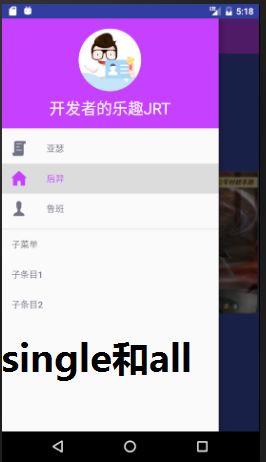NavigationView如此风骚的控件
以前我们做一个仿qq侧滑菜单的效果用的最多的是slidingmenu这个第三方库,我们也可以自己继承ViewGroup手动写。今天我为大家介绍在6.0以后Google在design包中提供一个NavigationView,NavigationView是用来展示一个侧滑菜单的列表的,要实现侧滑还是要用到support.v4中的DrawerLayout。两者配合效果确实很赞!
效果展示
<RelativeLayout
android:layout_width="match_parent"
android:layout_height="match_parent"
xmlns:app="http://schemas.android.com/apk/res-auto"
xmlns:tools="http://schemas.android.com/tools"
tools:context="com.itoutiao.news.navigationviewtest.MainActivity"
xmlns:android="http://schemas.android.com/apk/res/android">
<android.support.v4.widget.DrawerLayout
android:id="@+id/drawerlayout"
android:layout_width="match_parent"
android:layout_height="match_parent"
>
<LinearLayout
android:layout_width="match_parent"
android:layout_height="match_parent"
android:orientation="vertical"
android:background="@color/colorPrimary"
>
<android.support.v7.widget.Toolbar
android:id="@+id/toolbar"
android:layout_width="match_parent"
android:layout_height="?attr/actionBarSize"
android:background="@color/color_theme"
>
android.support.v7.widget.Toolbar>
<ImageView
android:layout_width="match_parent"
android:layout_height="match_parent"
android:src="@drawable/bg"
/>
LinearLayout>
<android.support.design.widget.NavigationView
android:id="@+id/nv_view"
android:layout_width="match_parent"
android:layout_height="match_parent"
android:layout_gravity="left"
app:headerLayout="@layout/header_layout"
app:menu="@menu/nv_menu"
/>
android.support.v4.widget.DrawerLayout>
RelativeLayout>
参数说明
header_layout.xml布局如下:
<LinearLayout xmlns:android="http://schemas.android.com/apk/res/android"
android:orientation="vertical"
android:layout_width="match_parent"
android:layout_height="match_parent"
android:gravity="center"
android:background="@color/color_theme"
>
<ImageView
android:layout_width="100dp"
android:layout_height="100dp"
android:src="@drawable/ic_authentication"
android:layout_marginTop="16dp"
/>
<TextView
android:id="@+id/tv_head"
android:layout_width="wrap_content"
android:layout_height="wrap_content"
android:text="开发者的乐趣JRT"
android:textSize="25sp"
android:textColor="@color/color_txt"
android:layout_marginTop="10dp"
android:layout_marginBottom="16dp"
/>
LinearLayout>
<menu xmlns:android="http://schemas.android.com/apk/res/android">
<group
android:id="@+id/nv_group"
android:checkableBehavior="single">
<item
android:id="@+id/it_yase"
android:checked="true"
android:icon="@drawable/ic_project_pressed"
android:title="亚瑟" />
<item
android:id="@+id/it_houyi"
android:icon="@drawable/ic_home_pre"
android:title="后羿" />
<item
android:id="@+id/it_luban"
android:icon="@drawable/ic_mycenter_pressed"
android:title="鲁班" />
group>
<item
android:icon="@drawable/ic_authentication"
android:title="子菜单">
<menu>
<item
android:id="@+id/sb_item1"
android:title="子条目1" />
<item
android:id="@+id/sb_item2"
android:title="子条目2" />
menu>
item>
menu>注意:子菜单的icon设置是不显示的,只能显示文字
- 通过 android:checked=”true”这个属性设置默认第一条是选中的。
具体选中事件还是要在java代码中注册;
//给NavigationView设置条目点击事件
mNvView.setNavigationItemSelectedListener(new NavigationView.OnNavigationItemSelectedListener() {
@Override
public boolean onNavigationItemSelected(@NonNull MenuItem item) {
//设置条目选中状态
item.setChecked(true);
//关闭侧滑菜单
mDrawerlayout.closeDrawers();
return true;
}
});java代码中动态变化
- 将DrawerLayout和Toolbar关联使用
/将DrawerLayout和Toolbar关联使用 显示出三条横线的icon
ActionBarDrawerToggle toggle=new ActionBarDrawerToggle(mContext,mDrawerlayout,mToolbar,0,0);
//开启异步
toggle.syncState();
//监听toggle的状态,控制菜单的显示于隐藏
mDrawerlayout.addDrawerListener(toggle);- 菜单的Item的选中状态颜色的变化
//一个存放颜色的数组
int[] colors = new int[] { ContextCompat.getColor(this, R.color.icon_pre),
ContextCompat.getColor(this,R.color.icon_nor)};
//选择状态的二维数组
int[][] states = new int[2][];
states[0] = new int[] { android.R.attr.state_checked};
states[1] = new int[] {};//表示正常状态
ColorStateList tintList = new ColorStateList(states, colors);
//设置item的icon选中的状态
mNvView.setItemIconTintList(tintList);
//设置item的文本选中的颜色状态
mNvView.setItemTextColor(tintList);因为在开发中,一个app的主题色是一致的,点击前后的状态值不一样,这里就涉及到了ImageView的tint属性,动态渲染icon的颜色,具体的可以看我的这篇博客:Android代码实现状态选择器
如修改后的结果:

3. 动态修改headerLayout
看到有个论坛上有人问道如何获取到headerLayout中的View,我就自己研究了一下,代码如下:
View headerView = mNvView.getHeaderView(0);
TextView mTvHead = (TextView) headerView.findViewById(R.id.tv_head);
mTvHead.setText("王者荣耀");就这个getHeaderView(0)方法可以取出头布局,然后headerView.findViewById();取出具体的view进行操作。
如下图:

最后把java源码贴出来
/**
* 描述:NavigationView的使用
* 开发者:开发者的乐趣JRT
* 创建时间:2017-3-11 23:29
* CSDN地址:http://blog.csdn.net/Jiang_Rong_Tao/article
* E-mail:[email protected]
**/
public class MainActivity extends AppCompatActivity {
@InjectView(R.id.nv_view)
NavigationView mNvView;
@InjectView(R.id.drawerlayout)
DrawerLayout mDrawerlayout;
@InjectView(R.id.toolbar)
Toolbar mToolbar;
private MainActivity mContext;
@Override
protected void onCreate(Bundle savedInstanceState) {
super.onCreate(savedInstanceState);
setContentView(R.layout.activity_main);
mContext =this;
ButterKnife.inject(mContext);
init();
}
private void init() {
mToolbar.setTitle("开发者的乐趣JRT");
initItemStates();
//给NavigationView设置条目点击事件
setNavigationItemSelected();
//控制侧滑菜单和toolbar的状态
changeDrawerLayoutAndToolbarStates();
//修改头布局的文字或者图片
editHeaderTitle();
}
private void setNavigationItemSelected() {
//给NavigationView设置条目点击事件
mNvView.setNavigationItemSelectedListener(new NavigationView.OnNavigationItemSelectedListener() {
@Override
public boolean onNavigationItemSelected(@NonNull MenuItem item) {
//设置条目选中状态
item.setChecked(true);
//关闭侧滑菜单
mDrawerlayout.closeDrawers();
return false;
}
});
}
private void changeDrawerLayoutAndToolbarStates() {
//将DrawerLayout和Toolbar关联使用 显示出三条横线的icon
ActionBarDrawerToggle toggle=new ActionBarDrawerToggle(mContext,mDrawerlayout,mToolbar,0,0);
//开启异步
toggle.syncState();
//监听toggle的状态,控制菜单的显示于隐藏
mDrawerlayout.addDrawerListener(toggle);
}
/**
* 修改头布局
*/
private void editHeaderTitle() {
View headerView = mNvView.getHeaderView(0);
TextView mTvHead = (TextView) headerView.findViewById(R.id.tv_head);
mTvHead.setText("王者荣耀");
}
/**
* 初始化菜单的Item的选中状态
*/
private void initItemStates() {
//一个存放颜色的数组
int[] colors = new int[] { ContextCompat.getColor(this, R.color.icon_pre),
ContextCompat.getColor(this,R.color.icon_nor)};
//选择状态的二维数组
int[][] states = new int[2][];
states[0] = new int[] { android.R.attr.state_checked};
states[1] = new int[] {};//表示正常状态
//设置item的icon选中的状态
ColorStateList tintList = new ColorStateList(states, colors);
mNvView.setItemIconTintList(tintList);
//设置item的文本选中的颜色状态
mNvView.setItemTextColor(tintList);
}
}总结
Android Design Support Library中提供了很多好用的控件,值得我们去探索和学习,做出有Google官方提出的有Matrial Design设计风格的APP.
github:源码下载




